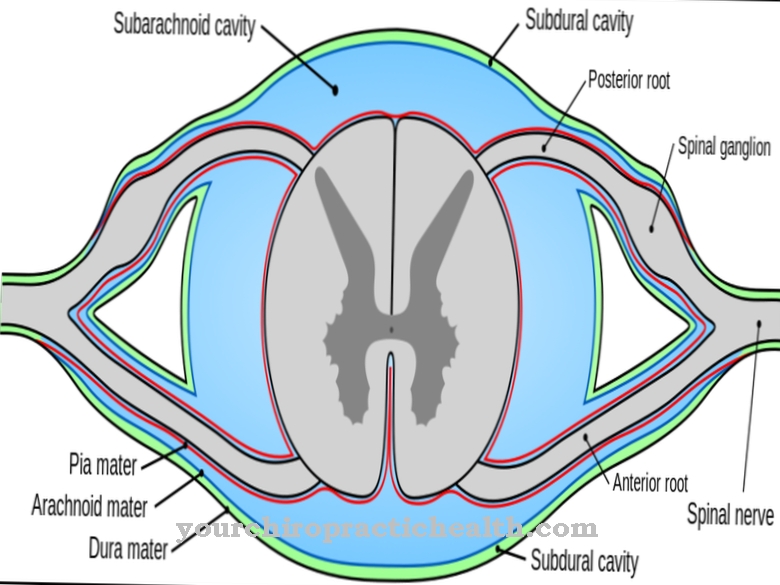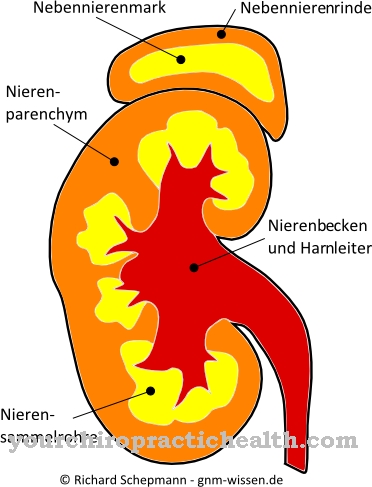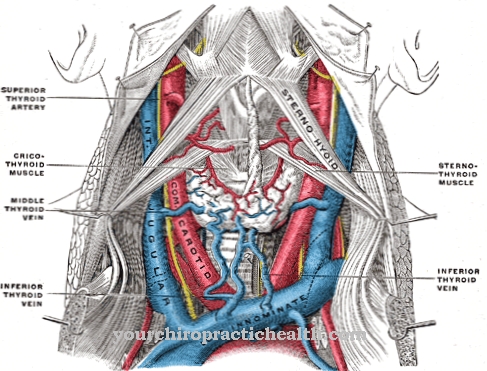So that the upper body of a person has a solid foundation, five sacral vertebrae provide adequate support. They lie between the lumbar vertebra and the tailbone. The sacrum vertebrae are firmly fused with each other and with the pelvis.
What is a sacrum
The Sacrum is a wedge-shaped bone. It consists of five vertebrae that have grown together. They are also called sacral vertebrae or sacral vertebrae. The sacrum is a part of the human spine. It forms the back of the bony pelvis.
The sacrum encloses the posterior section of the vertebral canal. It forms a unit with the hipbone, the pelvic girdle. The individual vertebrae that have grown together can still be recognized by the lines of growth.
The spinal nerves emerge from the sacrum. Together with the nerves emerging from the lower lumbar spine, they form a network. This network of nerves supplies the pelvis and legs. Medically, the sacrum is also known as the os sacrum.
Anatomy & structure
Despite the fusion of the vertebrae, the sacrum anatomically still offers all the characteristic features of vertebrae. The sacrum is laterally curved in a crescent shape and the spinous processes form a pronounced ridge, also known as the Christa sacralis mediana.
A joint surface lies on both sides on a small upward extension. It represents a connection to the last lumbar vertebra. The remaining articular processes form the ridge-like elevation already described. The transverse processes, on the other hand, form the lateral part, the broad plate (pars lateralis). The side parts of this plate are called the Christa sacralis lateralis.
In the lower back, there is a lot of weight on the sacrum. That is why it is particularly stable. It is located under the lumbar vertebrae and above the tailbone. It is connected to the pelvis via the sacrum-iliac joint. With the hip bones, it forms the bony pelvis or pelvic girdle.
The sacrum gives the upper body a firm base. The openings from which the spinal cord nerves emerge are located on its back. In some people, the uppermost sacral vertebra did not grow together with the other vertebrae. They have six instead of the usual five cross vertebrae.
As a result, the spine in these people has greater mobility. In return, however, they can only put less strain on their spine. This peculiarity of the vertebra is also called lumbarization.
Function & tasks
The sacrum enables movements, also called nutation or counter-nutation. The area between the 5th lumbar vertebra and the sacrum can be shifted forwards or backwards. This pushes the tip of the sacrum up or back.
The function of the sacrum is to give the body adequate support. Without the sacrum, the upper body would not have enough stability to move upright. The sacrum offers sufficient stability due to the fusion of the sacral vertebrae and the fusion with the pelvis.
The spine and pelvis are articulated to one another through the sacrum-iliac joint. It is a bony connection to the iliac bone of the pelvis. The sacrum is part of both the spine and the human pelvis.
It offers the nerves appropriate opportunities through its openings to form the nerve plexus that supplies the pelvis and legs. Without the sacrum, the human body would lack its natural support. He would collapse. With every movement, the sacrum offers the appropriate stability, whether when standing, running or sitting.
It keeps the body upright and cushions the weight created by the movement. The sacrum-iliac joint is also called the ilio-sacral joint (ISG). Since it is fixed with very tight ligaments, it has little room for maneuver. This joint is particularly stressed when sitting. This position greatly stretches the ligaments and puts pressure on the joint.
Diseases & Pain
Pain in the sacrum can result from long, incorrect or crooked sitting. Since the vertebrae in the sacrum are fused, they cannot simply be loosened. In the event of severe pain in the sacrum area, a doctor should definitely be consulted in order to localize the cause of the pain.
Acute pain is treated with medication or physiotherapy. There are certain exercises that counteract the pain in the sacrum. This loosens the pelvis and relieves tension. Severe pain can also arise when the sacrum-iliac joint is blocked. These blockages are deviations from normal joint function. The joint surface can be modified functionally or structurally.
Furthermore, the soft tissue jacket can also have corresponding changes. When there is a blockage, there is still a free direction of movement. The cause can be a blockage of this ISG due to a lifting trauma or a step into the void, for example when overlooking a step.
However, blockage can also be an accompanying symptom. For example, in the case of an orthopedic illness, after pain operations or as part of a spinal disease. A syndrome blockage can lead to severe back pain, which is usually one-sided.
Exercise and the application of heat can reduce the pain, but it can also worsen if you sit for a long time. The pain is radiating and can be felt in the buttocks area and the lumbar spine. Sensitivity disorders such as persistent tingling can also occur. The SI joint can be adjusted again using various mobilization techniques.
However, the SI joint can also be inflamed. Inflammation in this area often occurs in the context of Bechterew's disease or other rheumatic diseases. Inflammatory pain in the sacrum includes spondyloarthropathy or spondylarthritis.
You can find your medication here
➔ Medicines for back pain
























.jpg)



